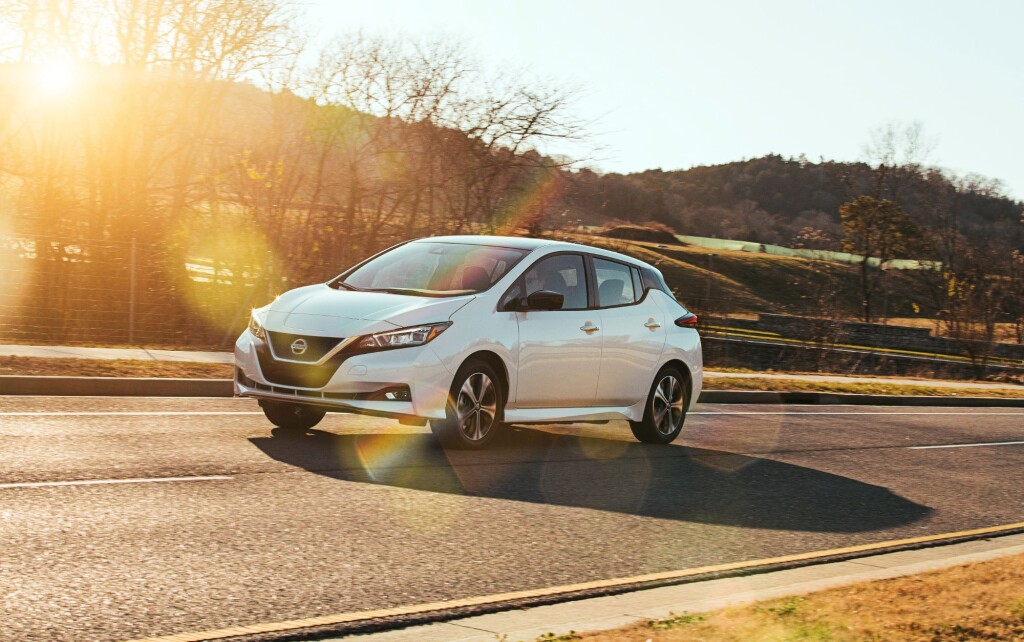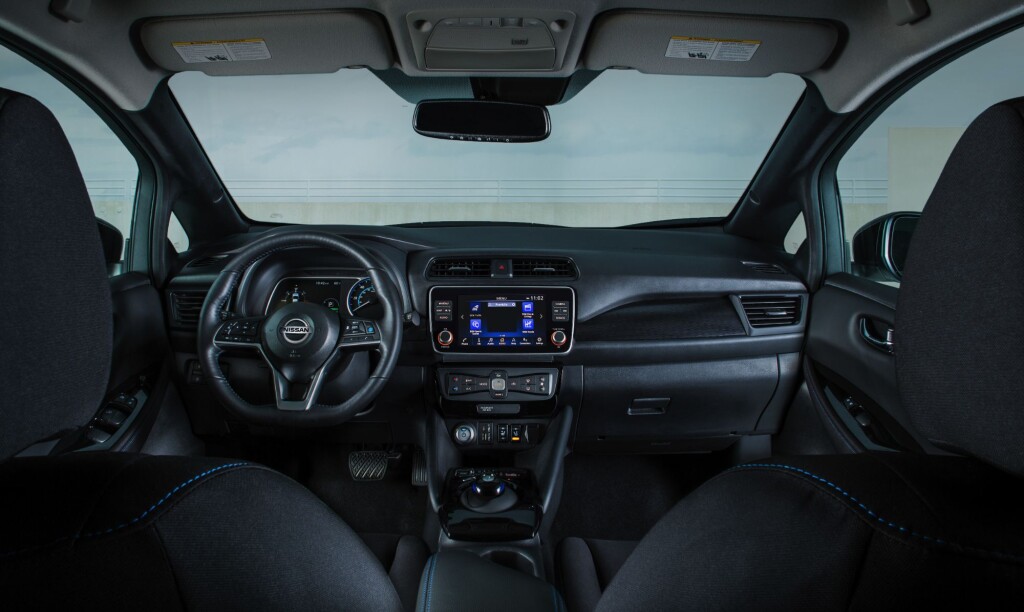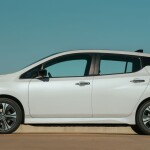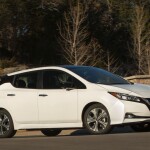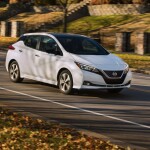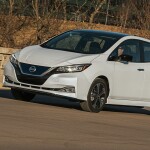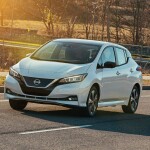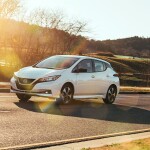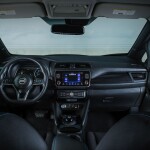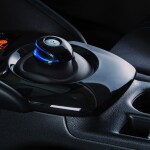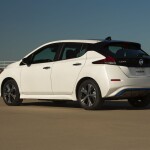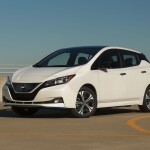If the Nissan Leaf wasn’t the Nissan Leaf, it would be just another small hatchback in an increasingly crowded field of small hatchbacks.
But, in fact, the Nissan Leaf is something a bit different. Like Clark Kent, it has a plain sort of exterior that belies what is underneath: an all-electric powertrain. It holds the distinction of being the first mass-market electric vehicle to come to America when it debuted for the 2011 model year.
I’ve had several occasions to spend a week with an all-electric vehicle, most recently the Chevy Bolt. I never had a week with the very first all-electric vehicle to hit American shores however, that is until a short time ago.
Nissan sent me a 2020 Leaf for a recent week. There was a time when the thought of any vehicle other than something powered by pure gas was a huge turnoff to me, like Rosanne Barr wearing lingerie turnoff. My very first time with anything besides dinosaur power under the hood came via a hybrid, a Toyota Prius to be exact. I absolutely hated it. The interior was uninspired, the cloth upholstery stunk, and it was way underpowered.
My, how times have changed.
Nissan sent me the 2020 Leaf SV Plus and it shows that today’s electric and hybrid vehicles have indeed come quite a long way.
The second generation of the Leaf made its debut in 2018. For 2020, Nissan added more standard driver-assistance features, more airbags, and standard Apple CarPlay and Android Auto smartphone integration.
There are two versions of the Leaf: the regular and Plus. The two differ mainly in their battery. The regular Leaf has a 40-kWh battery that’s good for about 150 miles of range. Nissan upgrades the Leaf Plus with a 60-kWh battery that provides 226 miles of range. The Plus also has a more powerful 214-horsepower electric motor compared to the regular model’s 147-hp motor.
Plus, or not, there are three trims: S, SV, and SL. The base S comes with such things as keyless ignition and entry, automatic climate control, a height-adjustable driver’s seat, an 8-inch touchscreen, and Apple CarPlay and Android Auto smartphone integration. You can add a Charge package (standard on the Leaf Plus S) includes a DC fast-charger port (CHAdeMO standard) and a portable charge cable capable of connecting to 120- and 240-volt sources.
The Leaf comes in three trim levels: S, SV and SL. The S starts out with features such as keyless ignition and entry, automatic climate control, a height-adjustable driver’s seat, an 8-inch touchscreen, and the aforementioned Apple CarPlay and Android Auto smartphone integration.
The SV comes with the Charge package and adds standard features like a leather-wrapped steering wheel, adaptive cruise control, an integrated navigation system, and an upgraded audio system. Optional for the SV Plus is the SV Technology package. It adds LED headlights, a power-adjustable driver’s seat, a surround-view parking camera system, and Nissan’s ProPilot Assist system that adds enhanced versions of the adaptive cruise control and lane-keeping systems. You can also option in an All-Weather package with heated side mirrors, heated front seats and steering wheel, rear heater vents and a heat-pump cabin heater.
The top-of-the-line SL adds leather upholstery, a Bose seven-speaker sound system and a cargo cover.
The fact that the Leaf would be just another hatchback if it wasn’t an electric car, is actually in my humble opinion, a very good thing. The early models of the non-gas vehicles tried to look like something futuristic. The Prius for example, looked pretty awful when it first came out. Sort of like something out of a B-grade science fiction movie.
I was struck at first at how little my Leaf SV Plus tester looked like an all-electric car. That’s not to say that I consider it a sleek aerodynamic rolling thing of beauty. But it sure doesn’t look like something Klaatu would be driving (or flying), around in.
The interior didn’t exactly score any style points with me, but it’s roomy and functional.
I still must get used to the lack of engine sound when you push “start”, but on the road the 214-horsepower electric motor performed just fine and there was actually a decent amount of torque meaning pickup from a dead stop was a nice surprise. After running a few short errands, and a bit of reading of the owner’s manual, I plugged in the charging cable into a household outlet. Beyond tripping a breaker once (dad my hair dryer just quit working!), I charged the Leaf on a regular outlet and added 20 miles in the span of 5 hours. Sort of impressive, to me at least. And while driving around town I used the e-Pedal feature which let me toggle back and forth between regenerative braking modes, one of which allows the car to coast when you lift off the pedal and another that dramatically slows the car and uses that energy to recharge the battery. This seemed to stretch the battery charge a bit.
With more and more fast chargers popping up around towns, and if I were to shell out a few bucks to put a charger on my house, I don’t think I’d have an issue with having a Leaf, or any all-electric car, fulltime. The office I used to work at recently installed fast chargers, and more workplaces are doing the same so it wouldn’t be a stretch anymore to commute during the week and running errands on the weekends. Not sure if a long road trip is possible yet, but things are getting better.
For 2021, Nissan seems to be set to carryover the second generation, and that’s not a bad thing. The only minor criticism I might have is the need for a bit of styling update, however, for the next few years the Leaf should be fine. Let’s hope that somewhere though pencils are starting to sketch.
So then let’s celebrate a bit. The Leaf is the one that began it all and despite my once utter loathing for all things not powered by long dead dinosaurs, I’m slowly warming up to them. The Leaf shows the future for all-electric cars is a bright one. It may be the first, but it certainly won’t be the last.
The 2020 Nissan Leaf SV Plus
MSRP: $39,750
MSRP (as tested): $42,670
Engine: High-response 160 kW AC synchronous motor, laminated 62 kWh lithium-ion battery
214 Horsepower, 250 lb-ft torque
Transmission: 1-speed automatic
Base Curb Weight (pounds): 3909
Range: Up to 226 miles
Exterior Dimensions (inches)
Wheelbase:106.3
Length: 176.4
Width, without mirrors: 70.5
Height: 61.6
Front Track Width: 60.2
Rear Track Width: 60.8
Interior Dimensions
Passenger / Seating Capacity 5
Total Passenger Volume (cubic feet) 92.4
Front Head Room (inches): 41.2
Front Leg Room (inches): 42.1
Front Shoulder Room (inches): 54.3
Front Hip Room (inches): 51.7
Second Row Head Room (inches): 37.3
Second Row Leg Room (inches): 33.5
Second Row Shoulder Room (inches): 52.5
Second Row Hip Room (inches): 50
Cargo Space/Area with Rear Seat Down: 30
Cargo Space/Area with Rear Seat Up: 23.6
Warranty
3 Basic Years / 36,000 Basic Miles
5 Drivetrain Years / 60,000 Drivetrain Miles
5 Corrosion Years / Unlimited Corrosion Miles
5 Hybrid/Electric Components Years / 60,000 Hybrid/Electric Components Miles
3 Roadside Assistance Years / Unlimited Roadside Assistance Miles
